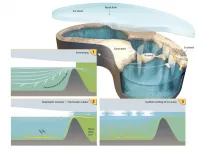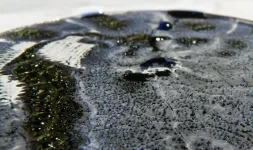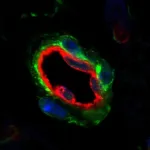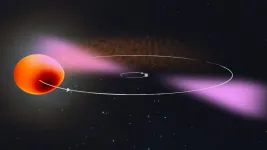(Press-News.org) The Arctic Ocean was covered by up to 900 m thick shelf ice and was filled entirely with freshwater at least twice in the last 150,000 years. This surprising finding, reported in the latest issue of the journal Nature, is the result of long-term research by scientists from the Alfred Wegener Institute and the MARUM. With a detailed analysis of the composition of marine deposits, the scientists could demonstrate that the Arctic Ocean as well as the Nordic Seas did not contain sea-salt in at least two glacial periods. Instead, these oceans were filled with large amounts of freshwater under a thick ice shield. This water could then be released into the North Atlantic in very short periods of time. Such sudden freshwater inputs could explain rapid climate oscillations for which no satisfying explanation had been previously found.
About 60.000 to 70.000 years ago, in a particularly cold part of the last glacial period, large parts of Northern Europe and North America were covered by ice sheets. The European ice sheet spanned a distance of more than 5000 kilometres, from Ireland and Scotland via Scandinavia to the Eastern rim of the Kara Sea (Arctic Ocean). In North America, large parts of what is now known as Canada were buried under two large ice sheets. Greenland and parts of the Bering Sea coastline were glaciated too. What was the ice situation like even further North, in the Arctic Ocean? Was it covered by thick sea-ice, or maybe with the tongues of these vast ice sheets were floating on it, far beyond the North Pole?
Scientific answers to these questions were more or less hypothetical so far. In contrast to deposits on land, where erratic boulders, moraines and glacial valleys are the obvious landmarks of glaciers, only few traces of vast ice shelves had been found so far in the Arctic Ocean. Geoscientists from the Alfred Wegener Institute Helmholtz Centre for Polar and Marine Research (AWI) and MARUM Center for Marine Environmental Sciences at the University of Bremen have now compiled existing evidence from the Arctic Ocean and the Nordic Seas, and combined it with new data to arrive at a surprising conclusion.
According to their study, the floating parts of the northern ice sheets covered large parts of the Arctic Ocean in the past 150,000 years. Once about 70,000-60,000 years ago and also about 150,000-130,000 years ago. In both periods, freshwater accumulated under the ice, creating a completely fresh Arctic Ocean for thousands of years.
"These results mean a real change to our understanding of the Arctic Ocean in glacial climates. To our knowledge, this is the first time that a complete freshening of the Arctic Ocean and the Nordic Seas has been considered - happening not just once, but twice," says the first author, Dr Walter Geibert, geochemist at the Alfred Wegener Institute.
Thorium is absent in the sediments, so saline water must have been absent
Their finding is based on geological analyses of ten sediment cores from different parts of the Arctic Ocean, Fram Strait and the Nordic Seas. The stacked deposits mirror the climate history of the past glacials. When investigating and comparing the sediment records, the geoscientists found that an important indicator was missing, always in the same two intervals. "In saline sea water, the decay of naturally occurring uranium always results in the production of the isotope thorium-230. This substance accumulates at the sea floor, where it remains detectable for a very long time due to its half-life of 75,000 years," Walter Geibert explains.
Therefore, geologists often use this thorium-isotope as a natural clock. "Here, its repeated and wide-spread absence is the giveaway that reveals to us what happened. According to our knowledge, the only reasonable explanation for this pattern is that the Arctic Ocean was filled with freshwater twice in its younger history- in frozen and liquid form," co-author and micropalaeontologist Dr Jutta Wollenburg, also from the AWI, explains.
A new picture of the Arctic Ocean
How can a large ocean basin, connected by several straits with the North Atlantic and the Pacific Ocean, turn entirely fresh? "Such a scenario is perceivable if we realize that in glacial periods, global sea levels were up to 130 m lower than today, and ice masses in the Arctic may have restricted ocean circulation even further," states co-author Professor Ruediger Stein, geologist at the AWI and the MARUM.
Shallow connections like Bering Strait or the sounds of the Canadian Archipelago were above sea level at the time, cutting off the connection with the Pacific Ocean entirely. In the Nordic Seas, large icebergs or ice sheets extending onto the sea floor restricted the exchange of water masses. The flow of glaciers, ice melt in summer, and rivers draining into the Arctic Ocean kept delivering large amounts of fresh water to the system, at least 1200 cubic kilometres per year. A part of this amount would have been forced via the Nordic Seas through the sparse narrow deeper connections in the Greenland-Scotland Ridge into the North Atlantic, hindering saline water from penetrating further north. This resulted in the freshening of the Arctic Ocean.
"Once the mechanism of ice barriers failed, heavier saline water could fill the Arctic Ocean again," Walter Geibert says. "We believe that it could then quickly displace the lighter freshwater, resulting in a sudden discharge of the accumulated amount of freshwater over the shallow southern boundary of the Nordic Seas, the Greenland-Scotland-Ridge, into the North Atlantic."
A concept that assumes that enormous amounts of freshwater were stored in the Arctic Ocean and available for rapid release would help understanding the connection between a range of past climate fluctuations. It would also offer an explanation for some apparent discrepancies between different ways of reconstructing past sea levels. "The remains of coral reefs have pointed to a somewhat higher sea level in certain cold periods than reconstructions from Antarctic ice cores, or reconstructions from the calcareous shells of small marine organisms, would suggest," explains Walter Geibert. "If we now accept that freshwater may not only have been stored in solid form on land, but some of it also in liquid form in the ocean, the different sea level reconstructions agree better and we can reconcile the location of the coral reefs with calculations of the freshwater budget."
Freshwater release from the Arctic Ocean might also serve as an explanation for some abrupt climate change events during the last glacial period. During such events, temperatures in Greenland could rise by 8-10 degree centigrade within a few years, only returning to the original cold glacial temperatures over the course of hundreds or thousands of years. "We see an example here of a past Arctic climate tipping point of the Earth system. Now we need to investigate in more detail how these processes were interconnected, and evaluate how this new concept of the Arctic Ocean helps in closing further gaps in our knowledge, in particular in view of the risks of manmade climate change," says Walter Geibert.
INFORMATION:
Original Publication:
Walter Geibert, Jens Matthiessen, Ingrid Stimac, Jutta Wollenburg, Ruediger Stein: Glacial episodes of a freshwater Arctic Ocean covered by a thick ice shelf. Nature (2021), DOI: 10.1038/s41586-021-03186-y
EMBARGOED until: Wednesday, 3 February 2021, 17:00 CET, 16:00 London Time, 11:00 US Eastern Time
What The Study Did: Data from the Centers for Disease Control and Prevention were used to look at changes in emergency department visits for mental health, suicide attempts, drug and opioid overdoses and outcomes of violence before and during the COVID-19 pandemic.
Authors: Kristin M. Holland, Ph.D., M.P.H., of the Centers for Disease Control and Prevention in Atlanta, is the corresponding author.
To access the embargoed study: Visit our For The Media website at this link https://media.jamanetwork.com/
(10.1001/jamapsychiatry.2020.4402)
Editor's Note: Please see the article for additional information, ...
What The Study Did: COVID-19 outcomes including hospitalization and in-hospital death were compared between people living with or without diagnosed HIV in New York State.
Authors: Eli S. Rosenberg, Ph.D., of the State University of New York in Rensselaer, is the corresponding author.
To access the embargoed study: Visit our For The Media website at this link https://media.jamanetwork.com/
(doi:10.1001/jamanetworkopen.2020.37069)
Editor's Note: The article includes conflict of interest and funding/support disclosures. Please see the article for additional information, including other authors, author contributions and ...
Mechanism for control of antibiotic production in soil bacteria is visualised for the first time by scientists at University of Warwick and Monash University
Research reported in Nature could lead to improved manufacturing of existing antibiotics, and open up opportunities to discover new ones
The majority of clinically used antibiotics are derived from soil bacteria, but can be hard to find because their production is switched off in laboratory cultures
The discovery of how hormone-like molecules turn on antibiotic production in soil bacteria could unlock the untapped opportunities for medicines that are under our very feet.
An international team of scientists working at the University of Warwick, UK, and Monash ...
ANN ARBOR, Mich. - The suicide rate among American adolescents has rose drastically over the last decade, but many at-risk youths aren't receiving the mental health services they need.
In fact, one of the greatest challenges is identifying the young people who need the most help.
Now, researchers have developed a personalized system to better detect suicidal youths. The novel, universal screening tool helps caregivers reliably predict an adolescent's suicide risk - alerting them to which ones need follow-up interventions - according to Michigan Medicine-led findings published in JAMA Psychiatry.
"Too many young people are dying by suicide and many at high risk go completely unrecognized and untreated," says lead author Cheryl King, Ph.D., ...
CAMBRIDGE, MA -- Twenty years ago this month, the first draft of the human genome was publicly released. One of the major surprises that came from that project was the revelation that only 1.5 percent of the human genome consists of protein-coding genes.
Over the past two decades, it has become apparent that those noncoding stretches of DNA, originally thought to be "junk DNA," play critical roles in development and gene regulation. In a new study published today, a team of researchers from MIT has published the most comprehensive map yet of this noncoding DNA.
This map provides in-depth annotation of epigenomic marks -- modifications indicating which genes are turned on or off in different types of cells -- across 833 tissues and cell types, a significant increase over ...
DALLAS - Feb. 3, 2021 - Gaining more fat cells is probably not what most people want, although that might be exactly what they need to fight off diabetes and other diseases. How and where the body can add fat cells has remained a mystery - but two new studies from UT Southwestern provide answers on the way this process works.
The studies, both published online today in Cell Stem Cell, describe two different processes that affect the generation of new fat cells. One reports how fat cell creation is impacted by the level of activity in tiny organelles inside cells called mitochondria. The other outlines a process that prevents new fat cells from developing in one fat storage area in ...
People with severe mental disorders have a significantly increased risk of dying from COVID-19. This has been shown in a new study from Umeå University and Karolinska Institutet in Sweden. Among the elderly, the proportion of deaths due to COVID-19 was almost fourfold for those with severe mental disorders compared to non-mentally ill people in the same age.
"We see a high excess mortality due to COVID-19 among the elderly with severe mental disorders, which gives us reason to consider whether this group should be given priority for vaccines," says Martin Maripuu, associate professor at Umeå University.
In the current study, the researchers studied data covering the entire Swedish population over the age of 20 during the period from 11 March to 15 June 2020. Among citizens ...
CABI scientists have updated the first major study of potential biological controls that could be used in the fight against the devastating fall armyworm in Africa. The research offers new insight into evidence of their efficacy in the field and increased availability as commercial products.
Indeed, the review, published in the Journal of Applied Entomology, includes many biocontrol products which are now featured in the CABI BioProtection Portal - a free web-based tool that enables users to discover information about registered biocontrol and biopesticide products around the world.
The fall armyworm ...
The behavior of the solvated electron e-aq has fundamental implications for electrochemistry, photochemistry, high-energy chemistry, as well as for biology--its nonequilibrium precursor is responsible for radiation damage to DNA--and it has understandably been the topic of experimental and theoretical investigation for more than 50 years.
Though the hydrated electron appears to be simple--it is the smallest possible anion as well as the simplest reducing agent in chemistry--capturing its physics is...hard. They are short lived and generated in small quantities and so impossible to concentrate and isolate. Their structure is therefore impossible to capture with direct experimental observation such as diffraction methods or NMR. Theoretical modelling has turned out to ...
An international research team including members from The University of Manchester has shown that a rapidly rotating neutron star is at the core of a celestial object now known as PSR J2039?5617
The international collaboration used novel data analysis methods and the enormous computing power of the citizen science project Einstein@Home to track down the neutron star's faint gamma-ray pulsations in data from NASA's Fermi Space Telescope. Their results show that the pulsar is in orbit with a stellar companion about a sixth of the mass of our Sun. The pulsar is slowly but surely evaporating this star. The team also found that the companion's orbit varies slightly and unpredictably over time. Using their search ...





